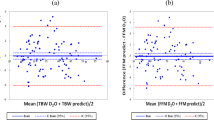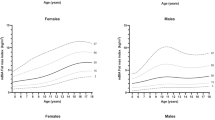Abstract
Background/objectives:
Obesity and undernutrition co-exist in many regions of Mexico. However, accurate assessments are difficult because epidemiological data on body composition are not available. The aim of this study was to facilitate assessments of body composition in Mexican school children of different geographical regions and ethnicity by developing equations for bioelectrical impedance and anthropometry based on deuterium oxide dilution.
Subjects/methods:
We evaluated 336 subjects (143 belonged to six major indigenous groups) from Northern, Central and Southern Mexico. We measured height (Ht), weight (Wt), tricipital skinfold (Tricp-SKF) and resistance (R) based on a bioimpedance analysis (BIA). Fat-free mass (FFM) and fat mass (FM) were estimated from measurements of total body water with the deuterium dilution technique.
Results:
The final BIA equation was FFM (kg)=0.661 × Ht2/R+0.200 × Wt−0.320. The R2 was 0.96; the square root of the mean square error (SRMSE) was 1.39 kg. The final anthropometric equation was FM (kg)=−1.067 × sex+0.458 × Tricp-SKF+0.263 × Wt−5.407. The R2 was 0.91; SRMSE was 1.60 kg. The BIA equation had a bias of 0.095 kg and precision of 1.43 kg. The anthropometric equation had a bias of 0.047 kg and precision of 1.58 kg.
Conclusions:
We validated two equations for evaluating body composition in Mexican indigenous and non-indigenous children and youth from three main regions of the country. These equations provided reliable estimates and will promote a better understanding of both obesity and undernutrition.
This is a preview of subscription content, access via your institution
Access options
Subscribe to this journal
Receive 12 print issues and online access
$259.00 per year
only $21.58 per issue
Buy this article
- Purchase on Springer Link
- Instant access to full article PDF
Prices may be subject to local taxes which are calculated during checkout


Similar content being viewed by others
References
Kennedy G, Nantel G, Shetty P . Assessment of the double burden of malnutrition in six case study countries. In: The Double Burden of Malnutrition. Case Studies from Six Developing Contries. FAO Food and Nutrition Paper No. 84., Food and Agriculture Organization of the United Nations: Rome, 2006 pp 1–18.
Secretaria de Salud. Acuerdo Nacional para la Salud Alimentaria. Estrategia contra el sobrepeso y la obesidad. Secretaría de Salud: México, 2010.
Dehghan M, Merchant AT . Is bioelectrical impedance accurate for use in large epidemiological studies? Nutr J 2008; 7: 26.
Kyle UG, Bosaeus I, De Lorenzo AD, Deurenberg P, Elia M, Manuel Gomez J et al. Bioelectrical impedance analysis-part II: utilization in clinical practice. Clin Nutr 2004; 23: 1430–1453.
Navarrete F . Los pueblos indígenas de México. CDI: México, 2008.
del Rio-Navarro BA, Velazquez-Monroy O, Sanchez-Castillo CP, Lara-Esqueda A, Berber A, Fanghanel G et al. The high prevalence of overweight and obesity in Mexican children. Obes Res 2004; 12: 215–223.
Haroun D, Taylor SJ, Viner RM, Hayward RS, Darch TS, Eaton S et al. Validation of bioelectrical impedance analysis in adolescents across different ethnic groups. Obesity 2010; 18: 1252–1259.
Programa de las Naciones Unidas para el Desarrollo. Informe Sobre Desarrollo Humano Mexico 2002. Mundi-Prensa Mexico: DF Mexico, 2003.
Yamamoto-Kimura L, Posadas-Romero C, Posadas-Sanchez R, Zamora-Gonzalez J, Cardoso-Saldana G, Mendez-Ramirez I . Prevalence and interrelations of cardiovascular risk factors in urban and rural Mexican adolescents. J Adolesc Health 2006; 38: 591–598.
de Onis M, Onyango AW, Van den Broeck J, Chumlea WC, Martorell R . Measurement and standardization protocols for anthropometry used in the construction of a new international growth reference. Food Nutr Bull 2004; 25 (Suppl 1), S27–S36.
Ramirez E, Valencia ME, Moya-Camarena SY, Aleman-Mateo H, Mendez RO . Four-compartment model and validation of deuterium dilution technique to estimate fat-free mass in Mexican youth. Nutrition 2009; 25: 194–199.
Fomon SJ, Haschke F, Ziegler EE, Nelson SE . Body composition of reference children from birth to age 10 years. Am J Clin Nutr 1982; 35: 1169–1175.
Schoeller DA . Hydrometry. In: Heymsfield SB, Lohman TG, Wang ZM, Going SB, (eds) Human Body Composition. Human Kinetics: Champaign IL, 2005, pp 35–50.
Lohman TG . Assessment of body composition in children. Pediatr Exerc Sci 1989; 1: 19–30.
Wells JCK, Fewtrell MS, Davies PSW, Williams JE, Coward WA, Cole TJ . Prediction of total body water in infants and children. Arch Dis Child 2005; 90: 965–971.
Wickramasinghe VP, Lamabadusuriya SP, Cleghorn GJ, Davies PS . Assessment of body composition in Sri Lankan children: validation of a bioelectrical impedance prediction equation. Eur J Clin Nutr 2008; 62: 1170–1177.
Guo SS, Chumlea WC, Cockram DB . Use of statistical methods to estimate body composition. Am J Clin Nutr 1996; 64 (Suppl 3), S428–S435.
Passing H, Bablok W . A new biometrical procedure for testing the equality of measurements from two different analytical methods. Application of linear regression procedures for method comparison studies in Clinical Chemistry, Part I. J Clin Chem Cli Biochem 1983; 21: 709–720.
Bland JM, Altman DG . Statistical methods for assessing agreement between two methods of clinical measurement. Lancet 1986; 1: 307–310.
de Onis M, Onyango AW, Borghi E, Siyam A, Nishida C, Siekmann J . Development of a WHO growth reference for school-aged children and adolescents. Bull World Health Organ 2007; 85: 660–667.
Haroun D, Taylor SJ, Viner RM, Hayward RS, Darch TS, Eaton S et al. Validation of bioelectrical impedance analysis in adolescents across different ethnic groups. Obesity 2010; 18: 1252–1259.
Sun SS, Chumlea WC, Heymsfield SB, Lukaski HC, Schoeller D, Friedl K et al. Development of bioelectrical impedance analysis prediction equations for body composition with the use of a multicomponent model for use in epidemiologic surveys. Am J Clin Nutr 2003; 77: 331–340.
Rush EC, Puniani K, Valencia ME, Davies PS, Plank LD . Estimation of body fatness from body mass index and bioelectrical impedance: comparison of New Zeland European, Maori and Pacific Island children. Eur J Clin Nutr 2003; 11: 1394–1401.
Schaefer F, Georgi M, Zieger A, Scharer K . Usefulness of bioelectrical impedance and skinfold measurements predicting fat-free mass derived from total body potassium in children. Pediatr Res 1994; 35: 617–624.
Withers RT, Laforgia J, Heymsfield SB . Critical appraisal of the estimation of body composition via two-, three-, and four-compartment models. Am Hum Biol 1999; 11: 175–185.
Huang TT-K, Watkins MP, Goran MI . Predicting total body fat from anthropometry in Latino children. Obes Res 2003; 11: 1192–1199.
Shaikh S, Mahalanabis D . Empirically derived new equations for calculating body fat percentage based on skinfold thickness and midarm circumference in preschool Indian children. Am J Hum Biol 2004; 16: 278–288.
Lohman TG, Caballero B, Himes JH, Davis CE, Stewart D, Houtkooper L et al. Estimation of body fat from anthropometry and bioelectrical impedance in Native American children. Int J Obes Relat Metab Disord 2000; 24: 982–988.
Acknowledgements
This research was performed at the Centro de Investigación en Alimentación y Desarrollo, AC. We gratefully acknowledge all participants, children and parents, for their collaboration. We also acknowledge the Secretaria de Educación Pública at the national level and the Secretaria de Educacion y Cultura from: Sonora, Chihuahua, Hidalgo, Puebla, Distrito Federal, Chiapas and Yucatan for facilitating access to families. We thank Elena Flores, Alfredo Pérez, Martha Barrera, Luis González, Carmen Vera, Alma Robles, José Ponce and Isabel Gardea for technical assistance. This research was supported by CONACyT, Convocatoria Salud 2003-C01-56 to MEV, a PhD scholarship to ER from the CONACyT, and IAEA (RLA/6/059).
Author information
Authors and Affiliations
Corresponding author
Ethics declarations
Competing interests
The authors declare no conflict of interest.
Rights and permissions
About this article
Cite this article
Ramírez, E., Valencia, M., Bourges, H. et al. Body composition prediction equations based on deuterium oxide dilution method in Mexican children: a national study. Eur J Clin Nutr 66, 1099–1103 (2012). https://doi.org/10.1038/ejcn.2012.89
Received:
Revised:
Accepted:
Published:
Issue Date:
DOI: https://doi.org/10.1038/ejcn.2012.89
Keywords
This article is cited by
-
Equations based on anthropometric measurements for adipose tissue, body fat, or body density prediction in children and adolescents: a scoping review
Eating and Weight Disorders - Studies on Anorexia, Bulimia and Obesity (2022)
-
Maternal Grandmothers’ Household Residency, Children’s Growth, and Body Composition Are Not Related in Urban Maya Families from Yucatan
Human Nature (2021)
-
Assessing the reliability of FTIR spectroscopy measurements and validity of bioelectrical impedance analysis as a surrogate measure of body composition among children and adolescents aged 8–19 years attending schools in Kampala, Uganda
BMC Public Health (2018)
-
Evaluation of simple body composition methods: assessment of validity in prepubertal Chilean children
European Journal of Clinical Nutrition (2015)
-
Bioelectrical impedance analysis to estimate body composition, and change in adiposity, in overweight and obese adolescents: comparison with dual-energy x-ray absorptiometry
BMC Pediatrics (2014)



